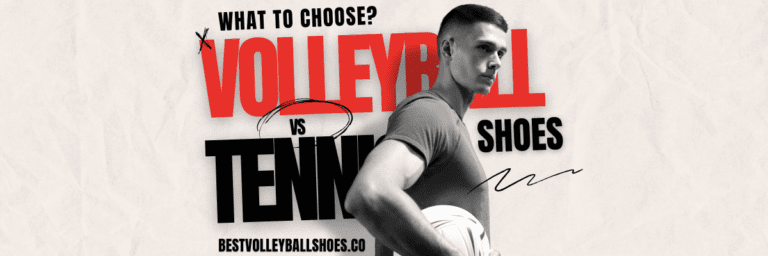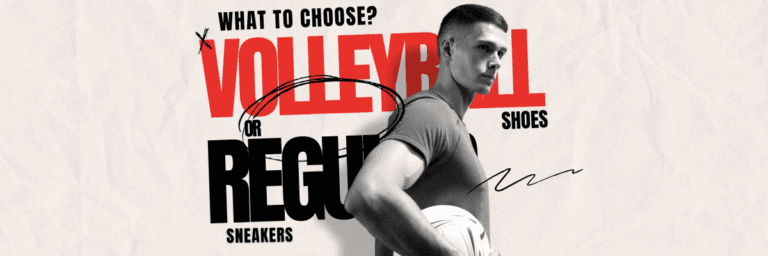How Are Volleyball Shoes Different from Other Athletic Footwear?
Introduction
“When you step onto the volleyball court, you bring your game. Shouldn’t your shoes do the same?”
Ah, the smell of freshly waxed wooden floors and the unmistakable sound of a ball slamming against the court—it’s game time. But wait! Before you make that killer serve or dive for a save, let’s talk footwear.
Because, let’s be honest, you wouldn’t go snorkeling with a leaky mask, so why step onto the court in subpar shoes?
Brief Overview of the Importance of Choosing the Right Athletic Shoes
Shoes are not just a fashion statement; they’re your foundational support. Imagine building a skyscraper on a base of toothpicks. It doesn’t sound very stable, does it?
The same goes for your athletic performance; it depends heavily on your choice of shoes. Pick the wrong pair, and you might as well be playing on banana peels. Slips, trips, and embarrassing faceplants could become your new best friends.
And let’s not forget comfort. Ever tried running in heels or hiking in flip-flops? Yeah, not fun. The right athletic shoes offer not just performance boosts but also unparalleled comfort.
A good pair should feel like an extension of you, as if you’re floating on air, or at least on a very cushy gym mat.
Thesis Statement
“Volleyball shoes are designed with specific features that set them apart from other athletic footwear, making them crucial for your performance and safety.”
Alright, folks, let’s cut to the chase. You’re not here to discuss the merits of shoe laces versus Velcro (though that would be a hoot). You’re here because you know volleyball isn’t just any sport; it’s THE sport.
And because it’s so special, it requires special shoes. Not your run-of-the mill, good for everything athletic shoes. Nope, we’re talking about shoes engineered for volleyball: rapid lateral movements, high jumps, and quick pivots.
By the end of this article, you’ll be itching to ditch your old kicks for a shiny new pair that could practically win the game on their own.
Alright, maybe not, but they’ll definitely help! So let’s dig into why volleyball shoes are the unsung heroes of the volleyball court.
The Basics: What Are Volleyball Shoes?
Definition and Brief History
Alright, let’s get down to brass tacks. What the heck are volleyball shoes? Well, in simple terms, they’re like the Swiss Army knives of the sports world, specially designed for the cut and thrust of volleyball action.
Picture this: it’s the 1960s, and volleyball is gaining popularity. Players are literally slipping and sliding in their regular gym shoes. Not ideal, right? Enter volleyball shoes! These bad boys came onto the scene with the grace of a ballet dancer and the grip of a wrestler.
You see, volleyball shoes have come a long way since their humble beginnings. Once upon a time, they were just a modified version of basketball shoes. Fast forward to today, and they’re a whole different beast.
Designed with all the bells and whistles to make you jump higher, move faster, and play better. Heck, some even come with “air mesh” and “gel cushioning” terms that sound like they’re straight out of a sci-fi movie.
Importance of Selecting the Right Shoes for Performance and Safety
Now, you might be thinking, “Hey, shoes are shoes. Why the big fuss?” Well, think again, my friend. Ever tried eating soup with a fork? It’s not just inefficient; it’s downright frustrating.
The same goes for wearing the wrong shoes in volleyball. You might get by, but you won’t be at the top of your game. And let’s face it, nobody wants to be that guy or gal making a face plant in the middle of an important match. Talk about a mood killer!
Similar to picking your teammates, finding the appropriate volleyball shoes is important. You want something that is dependable, matches your own style, and, most importantly, won’t fail you when the going gets tough.
The perfect pair might really help you perform better. You ask, how? They provide you with a greater grip for making rapid spins, more padding for doing high jumps, and more ankle support to help you avoid injuries. Your ankles will shout your praises, I promise.
In addition, let’s not undervalue the significance of safety while discussing injuries. Volleyball can be rather tight; make a mistake and you might be eliminated for the whole season.
The stability and support that proper footwear offers reduces the likelihood of injuries like ankle sprains and knee issues. It’s important to play intelligently as well.
In conclusion, volleyball shoes are your dependable allies on the court. They’re more than simply a pair of rubber and cloth; they’re a meticulously crafted tool designed to improve your performance.
You wouldn’t enter a fight brandishing a water cannon, and the same goes for entering the volleyball court with any old pair of trainers. Get the correct equipment, and you’ve already taken the first step towards success.
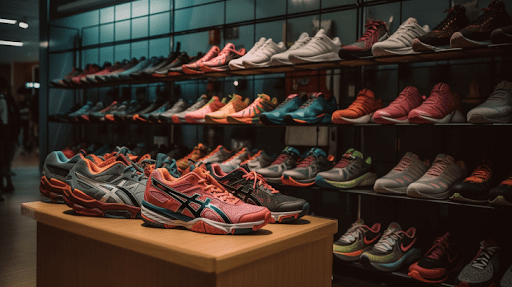
Anatomy of a Volleyball Shoe
The Upper: Materials and Design
Ah, the upper part of the shoe. This is where designers go all out to blend fashion with function. No, seriously, some of these shoes look like they walked straight off a Paris runway and onto the volleyball court.
But hey, it’s not all about looking good; it’s got to do the job too. The upper part usually uses lightweight materials like synthetic mesh or leather. Why? Because in volleyball, you want your feet to feel like they’re on vacation, breezy and relaxed.
The design usually features reinforced areas for better stability and support. Picture a sort of architecture for your feet, like building a sandcastle that won’t crumble when the tide comes in.
That’s right; these shoes are engineered to hold up under the pressure of those dramatic leaps and dives you’re so fond of making.
The Midsole: Cushioning and Support
If the upper is the showboat, the midsole is the unsung hero. You might not see it, but boy, do you feel it. This is where the magic happens in terms of cushioning and support. Think of it like your personal trampoline.
You know those jaw-dropping jumps you admire so much in professional players? A good chunk of that lift comes from the midsole.
Materials like EVA (ethylene vinyl acetate) or polyurethane make up this dreamy layer of comfort. It’s like having a set of mini mattresses under your feet. These materials not only cushion your landings but also provide resilience.
In other words, they bounce back, ready for action, just like you after a double espresso.
The Outsole: Traction and Grip
Alright, last but definitely not least, the outsole. This is the part of the shoe that plays footsie with the floor. If the upper is the brain and the midsole is the heart, the outsole is the brawny bouncer that keeps you from slipping into chaos.
It’s typically made of rubber and is designed with a variety of patterns to provide the best grip possible. The traction you get from a good outsole is like Spider-Man scaling a building; it sticks when you want it to and releases when you need it to.
The outsole is especially crucial in volleyball because of the sport’s fast-paced nature. You’re not just running in a straight line; you’re zigzagging, leaping, and sometimes even diving.
A good outsole gives you the confidence to make those moves without second guessing. It’s the difference between making that game-winning save and becoming a meme for all the wrong reasons.
Position-specific Requirements
Hitters and Blockers
“When it comes to jumping, it’s all about the lift.”
Ah, hitters and blockers, the rockstars of the volleyball world. You guys are the ones making the highlight reels with those jaw-dropping spikes and awe-inspiring blocks. But guess what?
You can’t pull off those moves in just any pair of sneakers. For you, it’s all about the lift. You need shoes that make you feel like you’ve got mini trampolines strapped to your feet.
The key here is to look for shoes with excellent cushioning and support in the midsole, as we talked about in our “Anatomy of a Volleyball Shoe” section. Remember those materials like EVA and polyurethane?
Yup, they’re your best pals. They give you that extra ‘oomph’ when you jump, almost like having a superhero cape for your feet. But let’s keep it real, even Superman couldn’t fly without a good lift off. So, next time you’re shopping for shoes, think about your vertical leap.
The higher you want to go, the more you need to focus on cushioning and bounce back capabilities.
Setters and Passers
“Quick feet need quick shoes.”
Setters and passers, you’re the unsung heroes of the team. You set the stage for those flashy hitters and blockers, but your game is all about speed and agility.
You’re not so much flying as zipping around the court like a hummingbird on a sugar rush. For you, the name of the game is lightweight and flexible footwear.
What you’re looking for is a shoe that almost feels like a second skin something that moves with you, not against you. It should be light enough to allow for quick footwork but sturdy enough to offer support.
Think about the upper material here. Go for something breathable, like a mesh upper, so your feet can stay cool even when the game heats up. The last thing you want is to feel like you’re dragging around bricks when you’re trying to set up that perfect pass.
And don’t forget about grip. You need to be able to change directions on a dime, which means you need an outsole that can grip the floor without sticking too much.
You don’t want to end up doing the moonwalk when you’re trying to dash to the other side of the court, right?

Court Surfaces and Shoe Types
Wooden Floors
“The classic volleyball stage.”
Ah, wooden floors—the classic, the quintessential, the stage where volleyball legends are made. There’s something about the polished glow of a wooden court that makes you want to dive right in, both literally and figuratively.
But before you go all in, let’s talk shoes. You see, wooden floors are generally more forgiving than their concrete counterparts, offering better shock absorption. But, like a cat on a hot tin roof, you’ll need to be cautious with your choice of footwear.
On a wooden floor, grip and flexibility are your best friends. You want shoes that adhere to the floor like gum to a sidewalk but also let you move freely. A rubber outsole with a unique grip pattern can make a world of difference.
Think of it like having the right tires on a sports car: you want grip for control but enough flexibility for speed. Plus, wooden floors can be a bit slippery, especially if they’re freshly waxed to a shine. The last thing you want is to pull off an accidental breakdance move in the middle of a game.
Concrete Floors
“A different beast altogether.”
Then we have concrete floors Think of them as the action movies of the volleyball world. They’re hard, unforgiving, and they can be tough on your feet. You wouldn’t go hiking in your favorite pair of loafers, so why would you play on concrete in shoes suited for wooden floors? Exactly, you wouldn’t.
Concrete floors call for a different set of shoe requirements. Cushioning takes the front seat here, given the unforgiving nature of the surface. Think of it like having a built in airbag for your feet.
The midsole should offer plenty of cushioning to absorb the impact, saving your joints from a pounding. And don’t skimp on durability; concrete can be pretty abrasive. You want an outsole made from a robust rubber compound that won’t wear out faster than you can say “match point.”
But don’t forget, no matter how tough the shoe, it still needs to offer a reasonable degree of flexibility and breathability. You’re not walking on a tightrope, but you do want a shoe that can withstand the harsher surface while still allowing you to move like the volleyball ninja you are.
The Importance of Breaking In Your Shoes
The Break-in Period
“No pain, no gain, but let’s minimize the pain.”
So, you’ve done your research, tried on a dozen pairs, and finally found “The One,” the pair of volleyball shoes that tick all your boxes. You can’t wait to show them off on the court, right?
Hold your horses! Or, in this case, hold your shoes. New volleyball shoes can be stiff, kind of like that one relative who insists on formal holiday dinners. In this case, you need to break them in, get them comfortable, and let them know how you roll or jump.
During this break-in period, you might experience some discomfort. Your feet are basically training your shoes to adapt to their unique shape and movement. It’s kind of like taming a wild horse; there might be a few bumps along the way, but the end result is worth it.
So, wear your new shoes around the house, during practice, or when you’re out for a light jog. Just don’t dive straight into a competitive match with them. Trust me, blisters and sore feet are not the kind of badges of honor you want to collect.
Tips for a Smooth Transition
“Baby steps to big leaps.”
Alright, so how do you make this break-in period as painless as possible? First off, patience, young Padawan. Rome wasn’t built in a day, and your shoes won’t break in after a single game.
Start by wearing them for short periods during non-competitive activities. Think of it as taking your shoes on a few “dates” before introducing them to your parents, or in this case, to the intensity of a real game.
Another pro tip is to wear the same type of socks that you’ll be using during matches. This helps your feet and shoes become the best of friends, fully understanding each other’s quirks and features.
And hey, if you’re feeling fancy, some players swear by using shoe stretchers or even stuffing the shoes with damp newspaper to speed up the process.
Also, don’t underestimate the power of shoe-specific insoles. They can offer extra cushioning and support, making the break-in period less of a break-in and more of a smooth transition.
It’s like adding training wheels to a bike; they help you get the hang of things before you go full throttle.
Volleyball-Specific Requirements
Quick Movements
“Be nimble, be quick.”
Okay, let’s state the obvious: volleyball is a fast-paced game. You’re not just jogging; you’re sprinting, leaping, diving, and maybe even doing some accidental gymnastics along the way.
For these quick-as-a-whip movements, you need shoes that are equally nimble. Ever seen a cat make a sudden sprint and change direction? Your shoes should let you do just that (minus the fur and whiskers).
Look for shoes with a lightweight design and excellent grip. You want to glide along the floor, not stick to it like you’ve stepped on gum. Materials matter here, too.
A flexible upper can help your foot move more naturally, allowing for those quick directional changes without any hiccups. It’s like dancing; you want to flow with the music, not fight against it. And in volleyball, the rhythm is fast, baby!
Ankle Support
“Your ankles will thank you.”
Volleyball is a high-impact sport, especially on your ankles. Think about it; you’re jumping, landing, and sometimes even crashing into other players. It’s like a rock concert down there, and your ankles are the lead singers. They take the brunt of the action, so they need solid support.
High-top designs or shoes with built-in ankle braces can be a lifesaver. They provide that extra bit of stability that helps prevent sprains and other injuries. It’s kind of like having a personal bodyguard for your ankles. So don’t skimp on this feature. Your future self, free from ankle braces and ice packs, will thank you.
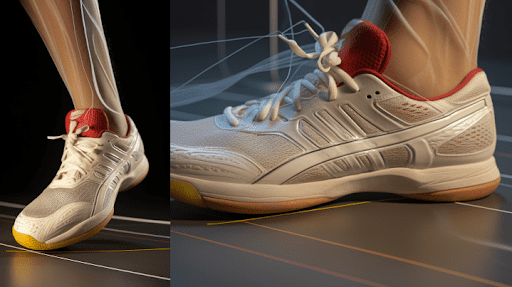
Floor Compatibility
“It’s not just you; it’s also where you play.”
Ah, the floor. It’s not just a stage; it’s an active participant in the game. As we discussed earlier, different floors require different types of shoes.
But it’s not just about the material of the floor; it’s also about its condition. Some floors might be smooth; others could be worn out. Some might be squeaky clean, while others… well, let’s not go there.
The point is, you need to choose shoes that are compatible with the floor you’ll be playing on most often. It’s like choosing a car; you wouldn’t pick a sports car for off road driving.
Take note of the floor’s characteristics Is it slippery, hard, or soft? Then, pick shoes with an outsole that complements these features. For instance, if you’re playing on a slippery wooden floor, you’ll want an outsole with excellent grip to avoid turning into Bambi on ice.
Key Differences Between Volleyball Shoes and Other Athletic Footwear
Weight
“Carry yourself, not your shoes.”
Let’s kick things off with weight, or rather, the lack thereof. Volleyball shoes are designed to be as light as a feather. Okay, maybe not that light, but you get the idea. Unlike running or basketball shoes, which often have more heft to them for added durability, volleyball shoes aim to make you forget you’re even wearing shoes at all.
The idea is to free you up, letting you focus on your game rather than the two mini weights attached to your feet. After all, you’ve got enough to carry the weight of the team’s expectations, am I right?
Grip
“Hold tight, but let go when you need to.”
Ah, grip, the clingy best friend of the athletic shoe world. You want it there when you need it but gone when you don’t. In volleyball, the grip has to be just right. Too much, and you risk injuring yourself as you change directions.
Too little, and you’ll find yourself sliding around like a penguin on ice. It’s a Goldilocks situation, and volleyball shoes nail it. The outsoles are engineered to provide excellent grip for quick lateral movements, something you won’t find in your average running or gym shoes.
Cushioning
“Like walking on clouds.”
Volleyball involves a lot of jumping. I mean, A LOT. And what goes up must come down, usually with a thud. That’s where cushioning comes in. Volleyball shoes offer superior cushioning to absorb the shock from all those leaps and bounds.
It’s like each shoe has its own built-in airbag. Running shoes, on the other hand, focus more on heel-to-toe movement and may not provide the same level of cushioning you need for vertical leaps. In other words, volleyball shoes are your fluffy landing pad, ensuring you descend like a feather, not a brick.
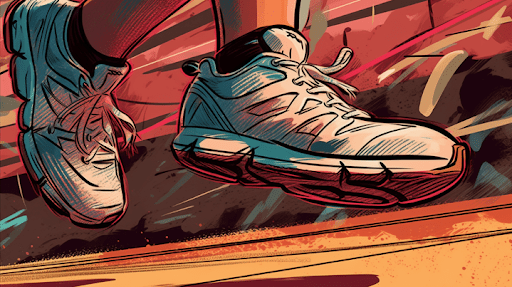
Breathability
“Air in, moisture out.”
Last but definitely not least, let’s talk about breathability. Volleyball can get intense, and intense often means sweating a lot of it. Volleyball shoes are designed to be breathable, allowing air to circulate freely.
It’s like having built-in air conditioning for your feet. Many feature mesh panels or perforated areas for optimal airflow. This is quite different from, say, basketball shoes, which might prioritize ankle support over breathability, potentially turning your feet into mini saunas.
How to Choose the Right Volleyball Shoes
Fit and Comfort
“Comfort is king.”
Listen up, folks: if your shoes aren’t comfortable, nothing else matters. You could have the most advanced, high-tech, out-of-this-world pair of volleyball shoes, but if they’re pinching your toes or rubbing your heel, you’re not going to play your best.
It’s like sleeping on a bed of nails; sure, it’s impressive, but why would you?
When trying on volleyball shoes, pay attention to how they feel the moment you put them on. Your feet should feel snug but not cramped, and you should be able to move your toes freely.
Don’t forget to wear the same kind of socks you’d wear during a match to get an accurate feel. Walk around, do a few jumps, maybe even a quick moonwalk whatever it takes to make sure they feel right.
Durability
“Built to last.”
Volleyball is an intense sport, and your shoes need to be up for the challenge
You wouldn’t go mountain climbing with a rope that’s fraying, so why hit the court with shoes that can’t withstand the pressure?
Look for shoes that feature high quality materials and solid construction. Pay special attention to areas that are likely to wear out first, like the outsole and the front tip. These areas should be reinforced for extra durability.
Another tip is to check out reviews or ask for recommendations from fellow players. You want shoes that have proven their mettle on the battlefield, or in this case, the volleyball court.
Because nothing’s worse than having your shoe fall apart in the middle of a match, except maybe losing the match because your shoe fell apart.
Style
“Because looking good is feeling good.”
Last but not least, let’s talk style. Now, we’ve all heard the saying, “It’s not about how you look, but how you play.” Well, guess what?
How you look can actually affect how you play! When you know you look good, you feel good, and when you feel good, you play well. Simple as that.
Luckily, volleyball shoes come in a variety of designs and colors, so you can definitely find a pair that fits your personal style. Want to make a statement?
Go for bold colors and eye-catching designs. Prefer to keep it classic? You can’t go wrong with a simple black or white pair. Just remember, style should be the cherry on top, not the whole sundae. Function should always come first.
Common Brands and Recommendations
Top 3 Brands for Different Levels of Players
Beginners: ASICS
Ah, ASICS, the bread and butter of volleyball shoes. They’re known for offering great entry level options that don’t break the bank. With good cushioning and decent durability, they’re perfect for beginners who are still learning the ropes, or nets, in this case.
Intermediate: Mizuno
For those who’ve graduated from the kiddie pool and are ready for the deep end, Mizuno offers a good balance of performance and comfort. They usually feature advanced grip technologies and excellent breathability. So if you’re past the point of casual rallies and into some serious spiking, Mizuno is worth a look.
Advanced: Nike
Nike is like the Rolls Royce of volleyball shoes. These are for the folks who live and breathe volleyball. With top-of-the-line materials, cutting edge technology, and a sprinkle of that Nike magic, these shoes are for those who are in it to win it.
Personal Recommendations Based on Experience and Reviews
Alright, let’s get personal—well, as personal as one can get when talking about shoes. Based on reviews and player feedback, here are some specific recommendations:
For Beginners: ASICS Gel Rocket
This model is often lauded for its exceptional comfort and support, making it a great choice for newbies. Plus, it’s pretty affordable, which is always a bonus when you’re just starting out and not sure how invested you are in the sport yet.
For Intermediate Players: Mizuno Wave Lightning
This shoe has been praised for its lightweight design and excellent grip, making it perfect for those quick moves and jumps. It’s a bit pricier than entry-level options, but hey, you’re not a beginner anymore, right?
For Advanced Players: Nike Hyperace
This is the shoe for those who eat, sleep, and breathe volleyball. With top tier cushioning, incredible durability, and that sleek Nike style, the Hyperace is for players who want nothing but the best.
Conclusion
Summary of Key Points
We’ve covered a lot of ground here, so let’s do a quick recap. We talked about the anatomy of a volleyball shoe, diving into the upper, midsole, and outsole. We also explored how different positions on the court have specific shoe requirements.
From the type of court surface you’ll be playing on to the importance of breaking in your shoes, we’ve discussed it all.
We even busted some common myths and misconceptions about volleyball shoes, just to make sure you’re not falling for any “fake news.” And let’s not forget our guide on how to choose the right pair, complete with brand recommendations for players at every level.
Final Thoughts
“Choosing the right volleyball shoes isn’t just an investment in footwear; it’s an investment in your game.”
Let’s get real for a moment. Your shoes are more than just a fashion statement or a protective layer for your feet. They’re your copilots, your wingmen, and your partners in crime on the volleyball court.
Choosing the right pair isn’t just about comfort or style; it’s about performance. The right shoes can elevate your game, giving you the confidence to make those incredible plays you’ve only dreamed of.
Think about it: Would Michael Jordan have been as legendary without his signature shoes? Probably, but the shoes sure didn’t hurt. Likewise, investing in the right volleyball shoes can make a world of difference in your game.
It’s not just about the jumps you make; it’s also about the landings. It’s not just about the speed you build; it’s also about the grip you maintain. In short, the right shoes can be the difference between a good game and a great one.
So go ahead, invest in that perfect pair. Try them on, break them in, and take them for a spin on the court. Because when you find “The One,” that perfect pair that fits like a dream and performs like a champ, you won’t just be stepping up your footwear game; you’ll be stepping up your entire volleyball game.
And hey, let’s be honest, who doesn’t want to be the MVP of both style and substance? So go ahead and make that investment. Your feet, and probably your team, will thank you. Game, set, match! 🏐
Frequently Asked Questions (FAQs)
What is footwear in volleyball?
Footwear in volleyball refers to specialized shoes designed to enhance performance on the court. These shoes typically offer superior grip, cushioning, and lateral support. They are engineered to be lightweight and breathable, enabling quick, agile movements. The specific requirements of volleyball, like jumping, diving, and rapid directional changes, necessitate such specialized footwear.
Can I wear volleyball shoes for running?
Technically, yes, you can wear volleyball shoes for running, but it’s not advisable. Volleyball shoes are optimized for indoor court use and quick lateral movements, not for the sustained forward motion and impact absorption required in running. Using them for running may lead to discomfort or even injury.
Why do people wear volleyball shoes?
People wear volleyball shoes to enhance their performance and reduce the risk of injury on the court. These shoes are specifically designed to provide excellent grip, allowing for quick lateral movements. They also offer superior cushioning to absorb the impact from jumps and dives. Breathability and ankle support are other key features. In short, they’re tailored to meet the unique demands of volleyball.
What is the difference between athletic shoes and basketball shoes?
Athletic shoes are a broad category that includes footwear for various sports and physical activities. Basketball shoes are a subtype designed for the specific demands of basketball, like quick turns, high jumps, and sprints. They often have high-top designs for ankle support and cushioning focused on the heel and forefoot. General athletic shoes may not offer these specialized features.
Is there a difference between volleyball shoes and basketball shoes?
Yes, volleyball and basketball shoes are designed for different types of movement and impact. Volleyball shoes are generally lighter and focus more on grip and cushioning to support quick, multi-directional movements and frequent jumps. Basketball shoes are often high-tops for ankle support and may have a heavier construction to endure the physicality of the sport.
What brand of shoes are used in volleyball?
Several brands specialize in volleyball shoes, including ASICS, Mizuno, and Nike. Each offers a range of options tailored to different skill levels, from beginners to professionals. These brands are known for combining technology and design to create footwear that enhances performance on the volleyball court.
Can you wear volleyball shoes as regular shoes?
While you could wear volleyball shoes as regular shoes, they’re not designed for everyday wear. Their specialized construction focuses on grip and cushioning for indoor courts, which might not offer the comfort or durability needed for general use, like walking on pavement.
Can volleyball shoes be used for badminton?
Some players do use volleyball shoes for badminton, as both sports require good grip, cushioning, and lateral support. However, badminton shoes are generally lighter and have a lower sole to allow quicker movements. While not ideal, volleyball shoes can be a temporary alternative.
What is the difference between men’s and women’s volleyball shoes?
The primary differences lie in sizing and design. Women’s volleyball shoes often come in narrower sizes and may offer different cushioning placements to accommodate the anatomical differences in foot shape. Design-wise, the color schemes and styles may also vary. However, the core features like grip, cushioning, and support remain consistent across both.


